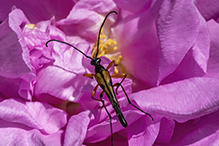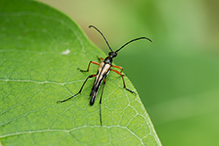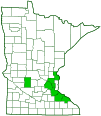Slender flower longhorn beetle
(Strangalia famelica solitaria)
Conservation • Description • Habitat • Ecology • Distribution • Taxonomy
Conservation Status |
|||
| IUCN Red List | not listed |
||
| NatureServe | NNR - Unranked |
||
| Minnesota | not listed |
||
Description |
Slender flower longhorn beetle is a medium-sized flower longhorn beetle. It occurs in the United States east of the Great Plains. In Minnesota it occurs in the southern half of the state, where it is at the northwest extent of its range. Larvae feed on dead and decaying hardwood, including birch and oak. Adults feed on the nectar of a variety of flowers including meadowsweet, dogwood, New Jersey tea, hydrangea, Queen Anne’s lace, and rose. Adults are ⅜″ to ⅝″ (10 to 17 mm) long. Males are slightly smaller and more slender than females. The body is slender and strongly tapered to the rear. The last segment of the abdomen is long, expanded, and notched underneath. On the female it is reddish-black. On the male it is black, more expanded, and more deeply notched. The head is angled forward in front and is abruptly constricted in back forming a neck that is visible when viewed from above. It is mostly black except for the yellow mouth parts. The compound eyes are large, black, and deeply notched. The antennae are thread-like, slender, entirely black, and long, about as long as the body. The base of each antenna is inserted in the notch in the compound eye. The first five antennal segments are densely covered with short, bristle-like hairs. All segments are uniformly slender. The third segment is much longer than the first (scape), the fourth is shorter than the third, and the fifth is longer than the fourth. The neck is yellow and has two black longitudinal stripes. The upper thoracic shield (pronotum) is bell-shaped and sinuate, narrow at the front, widening to the middle, narrowing just beyond the middle, then widening to the base. It is as wide at the base as the base of the hardened wing covers (elytra), and as long as the base is wide. It is slightly inflated on top. It has a shallow impression in the middle near the base. The angles at the rear corners of the pronotum are very sharp and point outward. The pronotal surface is densely covered with fine pits. It is also densely covered with short, gold and dark hairs. It may be yellow with two black longitudinal stripes that do not quite reach the base. It may also be entirely black. The elytra are long and narrow, about 3 times as long as wide. They taper evenly from the broad base to the narrow tip, making the body appear broad-shouldered. They are yellow with a variable amount of black marks. There is a black round spot near the middle (median spot) and a black elongated spot behind the median spot. The median spot is sometimes faded, sometimes absent. The inner margins (suture) and outer margins are narrowly black. The elytral surface is finely pitted and moderately covered with short gold and dark hairs. The legs are slender, mostly yellow, and densely covered with fine hairs. The fourth segment (tibia) of each leg has a spur at the tip. On the male the third segment (femur) of the hind leg is black on the outer (distal) half. The tibiae on the hind leg is ridged along the inside. On the female the femur is black just at the tip and the tibia is not ridged. The last part of each leg (tarsus), corresponding to the foot, is black. The tarsus has five segments but the fourth segment is minute and is concealed within the lobes of the heart-shaped third segment, making it appear that there are only four segments. On the hind leg, the tarsi are slender. The first segment is as long as all of the remaining segments together. The third segment is split beyond the middle. |
Size |
Total length: ⅜″ to ⅝″ (10 to 17 mm) |
Similar Species |
Habitat |
Woodlands |
Ecology |
Season |
May to July |
Behavior |
|
Life Cycle |
|
Larva Food |
Decaying hardwoods, including birch and oak |
Adult Food |
Nectar of a wide variety of flowers including meadowsweet, dogwood, New Jersey tea, hydrangea, Queen Anne’s lace, and rose. |
Distribution |
||
|
Sources |
|
| 9/17/2025 | ||
Occurrence |
||
|
||
Taxonomy |
|
Order |
Coleoptera (Beetles) |
Suborder |
Polyphaga (Water, Rove, Scarab, Long-horned, Leaf, and Snout Beetles) |
Infraorder |
Cucujiformia |
Superfamily |
Chrysomeloidea (leaf beetles and allies) |
Family |
Cerambycidae (longhorn beetles) |
Subfamily |
Lepturinae (flower longhorn beetles) |
Tribe |
Lepturini |
Genus |
Strangalia |
| Species | slender flower longhorn beetle (Strangalia famelica) |
|
|
|
Superfamily |
|
Subordinate Taxa |
|
|
|
Synonyms |
|
Ophistomis famelica solitaria |
|
Common Names |
|
slender flower longhorn beetle midwestern slender flower longhorn |
|
Glossary
Elytra
The hardened or leathery forewings of beetles used to protect the fragile hindwings, which are used for flying. Singular: elytron.
Femur
On insects and arachnids, the third, largest, most robust segment of the leg, coming immediately before the tibia. On humans, the thigh bone.
Pronotum
The exoskeletal plate on the upper side of the first segment of the thorax of an insect.
Tarsus
On insects, the last two to five subdivisions of the leg, attached to the tibia; the foot. On spiders, the last segment of the leg. Plural: tarsi.
Tibia
The fourth segment of an insect leg, after the femur and before the tarsus (foot). The fifth segment of a spider leg or palp. Plural: tibiae.
Visitor Photos
Share your photo of this insect.
This button not working for you?
Simply email us at info@MinnesotaSeasons.com.
Attach one or more photos and, if you like, a caption.
Greg Watson |
 |
Slender Flower Longhorn Beetle feeding on a rose flower. |
Brent Haglund |
 |
MinnesotaSeasons.com Photos
|

Slideshows

Visitor Videos
Share your video of this insect.
This button not working for you?
Simply email us at info@MinnesotaSeasons.com.
Attach a video, a YouTube link, or a cloud storage link.
Other Videos

Visitor Sightings
Report a sighting of this insect.
This button not working for you?
Simply email us at info@MinnesotaSeasons.com.
Be sure to include a location.
Greg Watson
6/14/2021
Location: in my backyard in La Crescent, MN.
Slender Flower Longhorn Beetle feeding on a rose flower.
Minnesota Seasons Sightings



